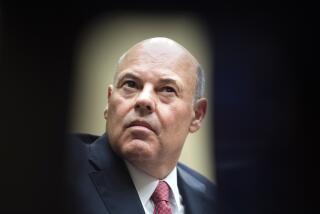Post Office Develops Plan to Slow Mail--on Purpose
- Share via
WASHINGTON — The U.S. Postal Service is developing a controversial plan to provide slower delivery of first-class mail.
Claiming that its customers prefer consistency over speed, the Postal Service wants to shrink the geographic zones in which it provides overnight delivery of first-class mail. More mail would be aimed for two-day and three-day delivery zones.
Under the current system, a letter dropped in a mailbox in downtown Los Angeles before 5 p.m. will be delivered the next day to locations as far away as San Diego, San Bernardino, Riverside, Santa Barbara, Oxnard and Bakersfield.
The new zones might increase the delivery time to two days for letters from downtown Los Angeles to San Diego and to Bakersfield.
As much as 20% to 30% of the nation’s first-class mail could be shifted into slower delivery schedules, according to Postal Service officials. In exchange, they promise that the reliability of delivery would be improved.
The proposed change already has drawn criticism, however. The consumer advocate for the independent Postal Rate Commission said the proposal would “degrade first-class mail service,” and he has invited state officials to intervene in hearings next week on the issue.
“You might also wish to inform your congressman of your comments,” the commission’s consumer advocate, Stephen A. Gold, said in a letter to the consumer protection offices of all 50 states. A copy of his letter was made available to The Times.
Gold said Friday he had taken the unprecedented step of inviting each state to become involved in the issue to ensure that the proposal was fully aired before being adopted.
“We didn’t think this case was getting the notice it should have gotten,” he said. “We felt that unless there is grass-roots involvement, this thing would just sail through. Maybe it should sail through, but we want to be sure people are going in with their eyes wide open.”
The New York Consumer Protection Board has asked to intervene in the case. “We believe that postal service customers oppose any additional delay in the delivery of first-class mail,” the board said.
Despite the hearings, the Postal Rate Commission has only an advisory role on this issue. Final decisions on delivery schedules are up to Postal Service management. The Postal Service can simply ignore any finding by the commission.
Postal Service officials have been discussing the new delivery zones with customers since October. They expect to announce the new delivery zones next year, with the changes to be phased in between February and September.
Generally, overnight delivery zones would be redrawn along metropolitan lines and would conform to local business marketing patterns.
For example, “a store in San Diego would not consider Los Angeles part of its local trading area,” said Greg Whiteman, director of the Postal Service office of market research and systems management. Mail between the two areas, which now moves overnight, might be put into the two-day delivery category.
The new zone plans will be drawn by Southern California division managers and their colleagues among the nation’s 73 postal divisions, Whiteman emphasized.
“We’re meeting with our customers, banks, insurance companies, cruise lines, telephone companies, and other major mailers to find out what they desire,” said David Mazer, communications manager for the Los Angeles division. “Then we will sit down with our counterparts in the rest of the basin and see what is best for all our customers.”
In return for slower service for some mail, the Postal Service would promise a higher rate of accurate deliveries. The current target calls for delivering 95% of the mail on time. The ratio of success is high in overnight zones--about 95 of every 100 letters deposited in a mailbox before 5 p.m. currently are delivered the next day.
But in a two-day zone, such as the region extending from Los Angeles to the Mississippi River, only 88% to 90% of the letters are delivered on time. The same performance applies to the three-day delivery, which covers letters between any two locations in the continental United States.
“We need to provide the level of consistency the market needs,” Whiteman said.
An 88% success ratio “is not good enough,” he said. “We need to get the level of performance up to the high 90s.”
The Postal Service plan is generating growing opposition among business groups.
The American Bankers Assn. and its postal service committee “have mobilized into action to fight this plan and need the help of bankers everywhere,” the association said in its weekly newspaper to bankers.
Noting that the Postal Service also is seeking higher rates in 1991, the ABA said “the end result may well be that banks will pay more for less service.” Gas and electric utility companies “could lose overnight service in some important areas,” the Council of Public Utility Mailers, a trade group, said in a filing with the Postal Rate Commission.
Postal officials were miffed at the efforts by Gold, the rate commission consumer advocate, to involve state officials in the issue. They initially suggested that he might be violating a federal law by allegedly using public funds to lobby Congress.
“It was an absurd way of trying to embarrass me, and had nothing to do with the issue of delivery standards,” Gold said. The Postal Service acknowledged in its most recent filing with the rate commission that no one had ever been prosecuted under the law.
More to Read
Sign up for Essential California
The most important California stories and recommendations in your inbox every morning.
You may occasionally receive promotional content from the Los Angeles Times.













